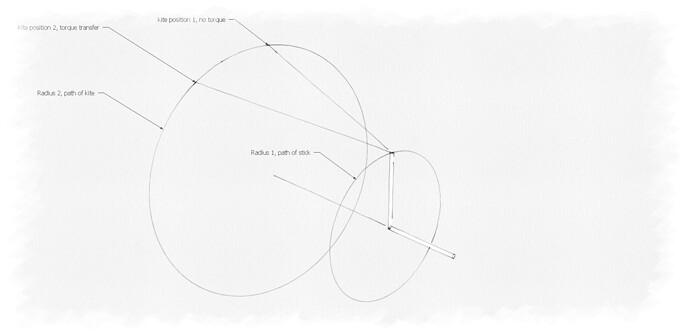Edit: Yes I’m drawing a circumference and calling it a radius there.
All is well when there is no torque transfer. The stick and the kite are in the same relative position on their circles and the kite is flying inside the wind window. The more the stick resists the rotation, the greater the angle between the stick and the line and so the worse the position of the kite seems to get in the wind window. But that assumes I think a two line kite. If you use a four line kite things change maybe. Maybe you can then keep the kite orientated better to the wind even if your lines are not.
So there seems to be a trade-off. If there is no angle difference between the kite and the stick your kite is moving fastest because it is sitting in the wind window, but you don’t have any moment to move the stick. If there is a 90 degree difference between the stick and the line, your potential moment is greatest, but your kite is outside of the wind window, so can’t exert any force.
So you have several variables you can play with, length of the stick, length of the line, shape of the cone the kite makes, angle difference between stick and line (or how much you are slowing down the kite), orientation of the kite to the wind if you’re not using a two line kite perhaps.
I’d think you wouldn’t want to slow the kite down too much. Is that right?
Also you want radius 2 in the diagram to be significantly greater than radius 1, or else why bother. But also perhaps no too much greater:
Thanks. Maybe there is way to find the optimum or this has already been researched. I’m probably going to try to find some research but I can’t think of useful search terms.
Thanks. My question is a bit different so perhaps that changes things. It only concerns itself with the top rung from your bottom picture, with the goal of increasing its swept area. which you could then attach to anything else, like a tower or a torque transfer system like yours for example.
Your top picture is interesting. I skimmed the paper but it didn’t seem to talk about this question. I haven’t had time yet to look into it further. Do you have a suggestion on where to start?
Same. But you can’t make the cone too thin or you’re with no swept area left, so what is optimal?
